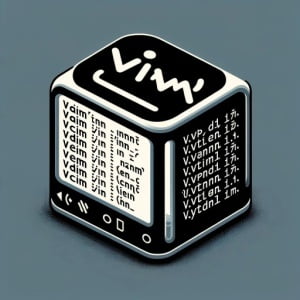Linux User’s Guide | Install Vim Command Seamlessly

Are you looking to install vim on your Linux system but aren’t sure where to start? Many Linux users might find the task intimidating, yet, vim, is a powerful text editor that is worth mastering. Vim offers a robust platform for editing plain text, especially for programmers. Additionally, it’s readily available on most package management systems, making the installation process straightforward once you know the steps.
In this tutorial, we will guide you on how to install the vim command on your Linux system. We will show you methods for both APT-based distributions like Debian and Ubuntu, and YUM-based distributions like CentOS and AlmaLinux. We’ll also delve into more advanced topics like compiling vim from source, installing a specific version, and finally, how to use the vim command and ensure it’s installed correctly.
So, let’s dive in and begin installing vim on your Linux system!
TL;DR: How Do I Install Vim in Linux?
In most Linux distributions, you can install Vim using the package manager. For Debian-based distributions like Ubuntu, use the command
sudo apt-get install vim. For RPM-based distributions like CentOS, usesudo yum install vim.
# For Debian-based distributions like Ubuntu
sudo apt-get install vim
# For RPM-based distributions like CentOS
sudo yum install vim
# Output:
# Reading package lists... Done
# Building dependency tree
# Reading state information... Done
# vim is already the newest version (2:8.1.2269-1ubuntu5).
# 0 upgraded, 0 newly installed, 0 to remove and 0 not upgraded.
This command will install Vim on your Linux system. But there’s more to Vim than just installation. Continue reading for a detailed guide on how to use Vim, its advanced features, and alternative text editors you can use on Linux.
Table of Contents
- Getting Started with Vim: An Essential Tool for Linux
- Installing Vim from Source
- Installing Different Versions of Vim
- Using Vim and Verifying Its Installation
- Exploring Alternatives: Nano and Emacs
- Common Issues and Solutions During Vim Installation
- Considerations When Using Vim
- The Role of Text Editors in Linux
- The Relevance of Text Editors in Larger Projects
- Wrapping Up: Installing Vim for Linux Systems
Getting Started with Vim: An Essential Tool for Linux
Vim, short for Vi Improved, is a highly configurable text editor built to enable efficient text editing. It’s an improved version of the vi editor distributed with most UNIX systems. Vim is often called a programmer’s editor, and so useful for programming that many consider it an entire IDE. It’s not just for programmers, though. Vim is perfect for all kinds of text editing, from composing email to editing configuration files.
Installing Vim in Debian-based Distributions
If you’re using a Debian-based distribution like Ubuntu, you can install Vim using the Advanced Packaging Tool (APT). Here’s how:
sudo apt update
sudo apt install vim
# Output:
# Reading package lists... Done
# Building dependency tree
# Reading state information... Done
# vim is already the newest version (2:8.1.2269-1ubuntu5).
# 0 upgraded, 0 newly installed, 0 to remove and 0 not upgraded.
The sudo apt update command updates your package lists. The sudo apt install vim command installs Vim on your system. If Vim is already installed, the system will inform you that ‘vim is already the newest version’.
Installing Vim in RPM-based Distributions
If you’re using an RPM-based distribution like CentOS, you can install Vim using the Yellowdog Updater, Modified (YUM). Here’s how:
sudo yum update
sudo yum install vim
# Output:
# Loaded plugins: fastestmirror, langpacks
# Loading mirror speeds from cached hostfile
# Package vim-enhanced-7.4.629-6.el7.x86_64 already installed and latest version
# Nothing to do
The sudo yum update command updates your package lists. The sudo yum install vim command installs Vim on your system. If Vim is already installed, the system will inform you that ‘Package vim-enhanced-7.4.629-6.el7.x86_64 already installed and latest version’.
Installing Vim in Arch-based Distributions
For Arch-based distributions like Manjaro, you can use the pacman package manager to install Vim. Here’s how:
sudo pacman -Sy vim
# Output:
# resolving dependencies...
# looking for conflicting packages...
# Packages (1) vim-8.2.1361-1
# Total Installed Size: 33.37 MiB
# :: Proceed with installation? [Y/n]
The sudo pacman -Sy vim command updates your package lists and installs Vim on your system. If Vim is already installed, the system will simply update it to the latest version.
Installing Vim from Source
For those who like to have the latest features or need a particular version of Vim, installing from source is the way to go. Here’s how you do it:
sudo apt-get remove vim vim-runtime gvim
sudo apt-get install libncurses5-dev python-dev python3-dev ruby-dev lua5.1 liblua5.1-dev libperl-dev git
cd ~
git clone https://github.com/vim/vim.git
cd vim
# Check Python Config Dir
python-config --configdir
# Use the output from the above command in the following command
./configure --with-features=huge --enable-multibyte --enable-rubyinterp=yes --enable-pythoninterp=yes --with-python-config-dir=/usr/lib/python2.7/config --enable-python3interp=yes --with-python3-config-dir=/usr/lib/python3.5/config --enable-perlinterp=yes --enable-luainterp=yes --enable-cscope
make
sudo make install
# Output:
# [Compiling Vim from source...]
This script first removes any pre-installed Vim packages. Then it installs the necessary dependencies for Vim. After that, it clones the Vim source code from the GitHub repository, configures it with a bunch of features, compiles it, and installs it.
Installing Different Versions of Vim
From Source
You can install a specific version of Vim from source by checking out the appropriate tag in the Vim git repository. Here’s how:
cd ~
git clone https://github.com/vim/vim.git
cd vim
git checkout v8.2.3451
make distclean
# Use the output from the python-config --configdir command in the following command
./configure --with-features=huge --enable-multibyte --enable-rubyinterp=yes --enable-pythoninterp=yes --with-python-config-dir=/usr/lib/python2.7/config --enable-python3interp=yes --with-python3-config-dir=/usr/lib/python3.5/config --enable-perlinterp=yes --enable-luainterp=yes --enable-cscope
make
sudo make install
# Output:
# [Installing Vim version 8.2.3451 from source...]
Using Package Managers
APT
To install a specific version of Vim using APT, you first need to find out what versions are available. Here’s how:
sudo apt-cache madison vim
# Output:
# vim | 2:7.4.1689-3ubuntu1.2 | http://us.archive.ubuntu.com/ubuntu xenial-updates/main amd64 Packages
# vim | 2:7.4.1689-3ubuntu1 | http://us.archive.ubuntu.com/ubuntu xenial/main amd64 Packages
Then you can install the desired version using the following command:
sudo apt-get install vim=2:7.4.1689-3ubuntu1.2
# Output:
# [Installing Vim version 2:7.4.1689-3ubuntu1.2...]
YUM
To install a specific version of Vim using YUM, you can use the following command:
sudo yum --showduplicates list vim | expand
# Output:
# Available Packages
# vim-enhanced.x86_64 2:7.4.629-6.el7 base
# vim-enhanced.x86_64 2:7.4.160-6.el7 updates
Then you can install the desired version using the following command:
sudo yum install vim-enhanced-2:7.4.160-6.el7
# Output:
# [Installing Vim version 2:7.4.160-6.el7...]
Version Comparison
Different versions of Vim come with different sets of features. Here’s a summary of some of the key changes in recent versions:
| Version | Key Features | Compatibility |
|---|---|---|
| 7.4 | Persistent undo, conceal text, Lua interface | CentOS 7, Ubuntu 16.04 |
| 8.0 | Asynchronous I/O, job control, packages, lambdas, closures, timers | CentOS 8, Ubuntu 18.04 |
| 8.1 | Run a terminal in a Vim window, popup windows | CentOS 8, Ubuntu 18.04, 20.04 |
| 8.2 | Text properties, Vim script debugger | CentOS 8, Ubuntu 20.04 |
Using Vim and Verifying Its Installation
Basic Vim Usage
To start Vim, just type vim in your terminal. This will open an empty Vim window.
vim
# Output:
# [Opens Vim]
You can also open a file by typing vim followed by the filename. For example:
vim myfile.txt
# Output:
# [Opens myfile.txt in Vim]
Verifying Vim Installation
You can verify that Vim is installed and check its version by typing vim --version in your terminal.
vim --version
# Output:
# VIM - Vi IMproved 8.2 (2019 Dec 12, compiled Mar 30 2020 21:23:04)
# Included patches: 1-486
# Compiled by [email protected]
# Huge version with Perl support... (output truncated for brevity)
This command will display a lot of information about your Vim installation, including the version number, the date it was compiled, the person who compiled it, the features that were enabled when it was compiled, and more.
Exploring Alternatives: Nano and Emacs
While Vim is a powerful text editor, it’s not the only game in town. There are other text editors available for Linux, each with its own strengths and weaknesses. In this section, we’ll introduce two popular alternatives to Vim: Nano and Emacs.
Nano: The Beginner-Friendly Editor
Nano is a simple, modeless, WYSIWYG command-line text editor included in most Linux distributions. It’s designed to be easy to use and is an excellent choice for beginners.
Installing Nano
You can install Nano using your distribution’s package manager. Here’s how to do it on Debian-based and RPM-based distributions:
# For Debian-based distributions like Ubuntu
sudo apt-get install nano
# For RPM-based distributions like CentOS
sudo yum install nano
# Output:
# Reading package lists... Done
# Building dependency tree
# Reading state information... Done
# nano is already the newest version (2.9.3-2).
# 0 upgraded, 0 newly installed, 0 to remove and 0 not upgraded.
Using Nano
You can start Nano by typing nano in your terminal. This will open an empty Nano window. You can also open a file by typing nano followed by the filename.
nano myfile.txt
# Output:
# [Opens myfile.txt in Nano]
Advantages and Disadvantages of Nano
Nano is simple to use and doesn’t have a steep learning curve like Vim or Emacs. However, it lacks many of the advanced features found in Vim and Emacs.
Emacs: The Extensible, Customizable, Self-documenting Editor
Emacs is a highly extensible text editor. It’s built on a C core, and nearly all of the higher-level functionality is implemented in Emacs Lisp, which is a dialect of the Lisp programming language.
Installing Emacs
You can install Emacs using your distribution’s package manager. Here’s how to do it on Debian-based and RPM-based distributions:
# For Debian-based distributions like Ubuntu
sudo apt-get install emacs
# For RPM-based distributions like CentOS
sudo yum install emacs
# Output:
# Reading package lists... Done
# Building dependency tree
# Reading state information... Done
# emacs is already the newest version (1:26.3+1-1ubuntu2).
# 0 upgraded, 0 newly installed, 0 to remove and 0 not upgraded.
Using Emacs
You can start Emacs by typing emacs in your terminal. This will open an empty Emacs window. You can also open a file by typing emacs followed by the filename.
emacs myfile.txt
# Output:
# [Opens myfile.txt in Emacs]
Advantages and Disadvantages of Emacs
Emacs is highly customizable and has a large number of features, including a built-in file manager (Dired), a mail reader, news reader, and more. However, Emacs has a steep learning curve, especially for users not familiar with Lisp.
Making the Choice
In the end, the choice of text editor depends on your needs. Vim is powerful and efficient, but it has a steep learning curve. Nano is simple and easy to use, but it lacks advanced features. Emacs is highly customizable and feature-rich, but it’s complex and can be overwhelming for beginners. Choose the one that best fits your needs and preferences.
Common Issues and Solutions During Vim Installation
While installing Vim is typically a straightforward process, you might encounter some issues. Here are a few common problems and their solutions.
Vim Package Not Found
Sometimes, you might encounter an error message saying that the Vim package is not found. This problem typically occurs when your package lists are not updated.
sudo apt install vim
# Output:
# Reading package lists... Done
# Building dependency tree
# Reading state information... Done
# E: Unable to locate package vim
To resolve this issue, update your package lists using the sudo apt update or sudo yum update command, depending on your distribution, and then try installing Vim again.
Vim Command Not Found
After installing Vim, you might find that your system doesn’t recognize the vim command. This issue can occur if the installation was not successful or if the system’s PATH does not include the directory where Vim is installed.
vim
# Output:
# Command 'vim' not found, but can be installed with:
# sudo apt install vim
To resolve this issue, you can try reinstalling Vim. If that doesn’t work, check your PATH using the echo $PATH command. If necessary, you can add the directory where Vim is installed to your PATH.
Vim: Command Not Found in CentOS
In CentOS, you might encounter an issue where the vim command is not recognized even after installation. This is because CentOS comes with a minimal version of Vim known as vi.
vim
# Output:
# Command 'vim' not found, did you mean:
# command 'tim' from deb tim
To resolve this issue, you need to install the enhanced version of Vim, vim-enhanced, using the command sudo yum install vim-enhanced.
Unable to Save Changes in Vim
As a beginner, you might find it challenging to save changes and exit Vim. This is because Vim uses different modes, and you need to be in command mode to save changes.
To save changes and exit Vim, press Esc to enter command mode, then type :wq and press Enter.
:wq
# Output:
# [Saves changes and exits Vim]
Considerations When Using Vim
When using Vim, keep in mind that it’s a modal text editor. It has different modes, including command mode and insert mode. You need to switch between these modes depending on whether you want to enter text or execute commands.
Also, Vim has a steep learning curve, especially for users not familiar with modal text editors. However, once you get the hang of it, you’ll find that Vim is a powerful tool that can greatly increase your productivity.
The Role of Text Editors in Linux
Text editors are an essential tool for every Linux user. Whether you’re a system administrator, a programmer, or a power user, you’ll find yourself using a text editor for many tasks.
What are Text Editors?
A text editor is a program that allows you to create and manipulate plain text files. Unlike word processors, text editors don’t add formatting to your text. This makes them ideal for writing code, editing configuration files, or any task that requires plain text.
Text Editors and Programming
For programmers, a good text editor is not just a tool, it’s a weapon. Text editors like Vim offer syntax highlighting, which makes code easier to read by coloring keywords, variables, and other elements. They also offer features like code folding, which allows you to collapse and expand sections of your code, making it easier to navigate complex files.
Here’s an example of how Vim’s syntax highlighting works:
# Python code
print('Hello, World!')
# Output:
# 'Hello, World!'
In the above code block, ‘print’ is a function in Python used to print the specified message to the screen. The text ‘Hello, World!’ is the message we want to print. In Vim, ‘print’ would be highlighted in a different color because it’s a keyword in Python.
Text Editors and System Administration
For system administrators, text editors are crucial for managing configuration files. These files, which are plain text, control the behavior of various programs. Using a text editor, a system administrator can open a configuration file and change settings as needed.
Here’s an example of how one might use Vim to edit the sshd_config file, which controls the behavior of the SSH daemon:
sudo vim /etc/ssh/sshd_config
# Output:
# [Opens sshd_config in Vim]
In the above code block, ‘sudo’ is a command that allows you to run programs with the security privileges of another user (by default, the superuser). ‘/etc/ssh/sshd_config’ is the path to the sshd_config file. ‘vim’ is the command to start Vim and open the specified file.
The Importance of Mastering a Text Editor
Mastering a text editor like Vim can significantly boost your productivity. Vim, for example, offers many powerful features, such as the ability to open multiple files at once, search and replace text across multiple files, and customizability through plugins and scripting. By learning how to use these features, you can perform tasks more efficiently and effectively.
The Relevance of Text Editors in Larger Projects
The impact of text editors extends beyond simple file editing – they are instrumental in shaping larger software projects. Their efficiency and versatility can influence the speed and quality of code development, affecting the overall project outcome.
Text Editors and Version Control Systems
Text editors like Vim play a significant role when working with version control systems like Git. They allow developers to write commit messages, resolve merge conflicts, and perform other tasks related to version control.
# Committing changes with Vim as the default editor
git commit
# Output:
# [Opens Vim for writing the commit message]
In the above example, git commit opens Vim to write a commit message. This integration of text editors and version control systems enables smoother and more efficient project management.
Text Editors and Programming Languages
Text editors are not language-specific. Whether you’re coding in Python, JavaScript, or Rust, text editors like Vim provide syntax highlighting, auto-indentation, and other language-specific features that can enhance your coding experience.
# Python code in Vim
def hello_world():
print('Hello, World!')
hello_world()
# Output:
# 'Hello, World!'
In the above Python code, Vim would highlight def, print, and other Python keywords, making the code easier to read and understand.
Further Resources for Mastering Vim
To deepen your understanding of Vim and its applications, consider exploring the following resources:
- Vim User Manual: This is the official Vim user manual, providing comprehensive information on every aspect of Vim.
Vim Tips Wiki: A community-driven platform offering a wealth of tips and tricks to enhance your Vim experience.
Learn Vimscript the Hard Way: If you’re interested in customizing Vim, this resource provides an excellent introduction to Vimscript, the scripting language used for Vim customization.
Mastering a text editor like Vim can significantly boost your productivity and efficiency, whether you’re a programmer, a system administrator, or a power user. So, why wait? Start your journey towards Vim mastery today!
Wrapping Up: Installing Vim for Linux Systems
In this comprehensive guide, we’ve explored how to install and use Vim, a powerful text editor, on Linux systems. We’ve covered the basic installation methods for both APT-based distributions like Debian and Ubuntu, and YUM-based distributions like CentOS and AlmaLinux. We’ve also delved into advanced topics such as compiling Vim from source, installing a specific version, and using the Vim command correctly.
We began with the basics, learning how to install Vim using the package manager of your Linux distribution. We then ventured into advanced usage, exploring how to compile Vim from source and install a specific version. Along the way, we also introduced you to some basic and advanced Vim commands that will help you in your coding journey.
We addressed common issues that you might encounter while installing and using Vim, offering practical solutions to help you overcome these challenges. We also discussed the importance of text editors in Linux systems, especially in programming and system administration.
We compared Vim with other popular text editors like Nano and Emacs, giving you a broader view of the options available to you. Here’s a quick comparison of these text editors:
| Text Editor | Complexity | Features | Customizability |
|---|---|---|---|
| Vim | High | High | High |
| Nano | Low | Moderate | Low |
| Emacs | High | Very High | Very High |
Whether you’re a beginner just starting out with Vim or an experienced user looking to brush up your skills, we hope this guide has provided you with a deeper understanding of Vim and its capabilities.
Mastering Vim can significantly boost your productivity and efficiency, especially if you’re a programmer or system administrator. With its powerful features and high customizability, Vim is more than just a text editor – it’s a tool that can enhance your coding experience. Happy coding!


